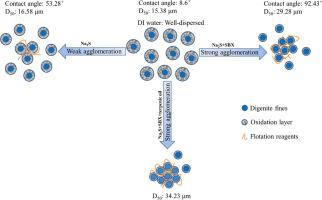Minerals Engineering ( IF 4.8 ) Pub Date : 2021-05-02 , DOI: 10.1016/j.mineng.2021.106932 Jiwei Xue , Dawei Ren , Tong Chen , Xianzhong Bu , He Wan , Zhenguo Song , Chen Zhao

|
Secondary copper sulfide mineral fine particles are easily oxidized, and their effective recovery by froth flotation is extremely challenging. This study investigated the roles of sodium sulfide (Na2S) and sodium butyl xanthate (SBX) in the hydrophobic agglomeration flotation of oxidized digenite fine particles. The microflotation experiments of the study showed that the simultaneous addition of Na2S and SBX is beneficial for improving the floatability of heavily oxidized digenite fine particles. In addition, the recovery at pH 7.0 was apparently higher than that of the unoxidized digenite fine particles, indicating that hydrophobic agglomeration of digenite fine particles may occur. The results of the zeta potential measurements, X-ray photoelectron spectroscopy analyses, and contact angle measurements suggested that negatively charged hydrogen sulfide ion and xanthate ion respectively hydrolyzed from Na2S and SBX adsorbed on the surface of digenite. Moreover, they significantly decrease the amount of hydrophilic copper sulfate and oxides/hydroxides on the surface, thus improving the surface hydrophobic degree of digenite. The results of the optical microscopy analysis, particle size analysis, and extended Derjaguin–Landau–Verwey–Overbeek theory calculations provided strong evidence for the roles of Na2S and SBX in promoting the hydrophobic agglomeration of the digenite fine particles. After treatment with Na2S and SBX, the total interaction energies between the digenite fine particles were negative, indicating that the strong hydrophobic attractive forces promote the formation of large-sized agglomerates, enabling the digenite fine particles to be more easily captured by bubbles than those without the treatment. Therefore, effective recovery of heavily oxidized digenite fine particles can be realized by the hydrophobic agglomeration flotation technology induced by Na2S and SBX.
中文翻译:

Na 2 S和黄原酸丁酯诱导的氧化重铬矿细颗粒的疏水团聚浮选
次级硫化铜矿物细颗粒容易被氧化,通过泡沫浮选有效地回收它们非常具有挑战性。这项研究调查了硫化钠(Na 2 S)和丁基黄药酸钠(SBX)在氧化的褐铁矿细颗粒的疏水团聚浮选中的作用。该研究的微浮选实验表明,同时添加Na 2S和SBX有利于改善重度氧化的重晶石细颗粒的漂浮性。另外,在pH 7.0下的回收率明显高于未氧化的重晶石细颗粒的回收率,表明重晶石细颗粒可能发生疏水团聚。ζ电势测量,X射线光电子能谱分析和接触角测量的结果表明,带负电荷的硫化氢离子和黄药离子分别从Na 2水解。S和SBX吸附在地gen石的表面上。而且,它们显着减少了表面上的亲水性硫酸铜和氧化物/氢氧化物的量,从而提高了重碳酸盐的表面疏水度。光学显微镜分析,粒度分析和扩展的Derjaguin–Landau–Verwey–Overbeek理论计算的结果为Na 2 S和SBX在促进地闪石细颗粒疏水团聚中的作用提供了有力的证据。用Na 2处理后在S和SBX的情况下,重晶石细颗粒之间的总相互作用能为负,表明强大的疏水吸引力促进了大块团聚体的形成,与没有处理的重晶石细颗粒相比,气泡更容易捕获重晶石细颗粒。因此,通过Na 2 S和SBX诱导的疏水团聚浮选技术,可以有效地回收重氧化的重晶石细颗粒。


























 京公网安备 11010802027423号
京公网安备 11010802027423号